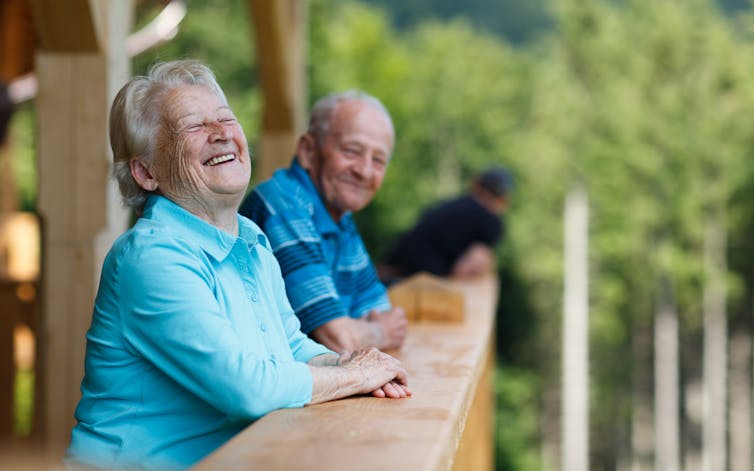We're not just living for longer – but we're staying healthier for longer, too
- Written by John Goss, Adjunct Associate Professor, Health Research Institute, University of Canberra
In the 12 years to 2015, life expectancy in Australia increased by 2.3 years for men (to 80.4) and 1.6 years for women (to 84.6). Our health-adjusted life expectancy increased along with it – by two years for men (to 71.5) and 1.3 years for women (to 74.4).
Health-adjusted life expectancy estimates the number of full health years people can expect to experience over the course of their lives. By comparing this measure to life expectancy, we can see whether longer life expectancy is accompanied by more years lived in full health.
Pleasingly, these trends show we’re not just living for longer – but we’re staying healthy for longer, too.
Read more: Health Check: why do women live longer than men?
In the Australian Burden of Disease study, released today, the Australian Institute of Health and Welfare has mapped the impact and causes of illness and death in Australia between 2003 and 2015.
The improvement in health-adjusted life expectancy alongside life expectancy in the last 12 years builds on continual improvements in life expectancy seen in Australia over several decades.
These improvements in our health can be accorded to advancements in science and medicine, and certain changes we’ve made in our lifestyles. But there’s still plenty of room to do better.
How have we achieved this?
Some 89% of the health improvement between 2003 and 2015 was due to improvements in heart health, reductions in cancer, and improved infant health.
Health improvement refers to reductions in the burden of disease, measured in disability adjusted life years (DALYs). DALYs take into account premature death as well as the burden of illness and disability caused by disease and injury.
Heart disease and stroke
In the period from 2003 to 2015, there was a 36% reduction in the age-standardised burden of disease due to heart disease and stroke. Improvements in heart health accounted for 56% of the overall improvement in health.
The vast majority of the reduction in the cardiovascular disease burden has been due to reductions in smoking, high blood pressure and high cholesterol. Some of the improvement is due to better treatment (for example, surgical interventions like stent insertions).
We’ve been seeing strong progress in this area over many years. The chance of dying from heart disease or stroke is now one sixth of what it was in 1970.
Read more: How Australians Die: cause #1 – heart diseases and stroke
Cancer and infant health
The reduction in the burden of disease from cancer, which accounted for 25% of the improvement in health, has been partly due to the reduction in risk factors such as smoking. Prevention through screening has also played an important role.
But improved treatment, in the form of drugs, radiation and surgery, has been the most important factor. Five year survival rates for cancer increased from 50% in 1986-1990 to 69% in 2011-2015.
Reductions in the burden of disease due to infant and congenital conditions accounted for 8% of the improvement in health between 2003 and 2015. This was due to improved treatment of infants with congenital conditions and better prevention of problems such as sudden infant death syndrome (SIDS).
 Advances in medicine – both prevention and treatment of disease – contribute to Australians living longer than they used to.
From shutterstock.com
Advances in medicine – both prevention and treatment of disease – contribute to Australians living longer than they used to.
From shutterstock.com
Managing our risk factors is key
Overall, reductions in risk factors has been responsible for 51% of the health improvement we’ve seen between 2003 and 2015.
Although some risk factors like overweight and obesity have worsened, the decline in smoking, high blood pressure, high cholesterol and alcohol use has more than compensated for those risk factors which have worsened or those risk factors, like physical inactivity, which have not improved.
We’re by no means reaching the end of the line in terms of opportunities to improve our health.
Some 38% of the burden of disease in 2015 was due to risk factors like smoking (still accounting for 9.3% of the burden), overweight and obesity (8.4% of the burden), poor diet (7.3%), high blood pressure (5.8%), excessive alcohol intake (4.5%), high cholesterol (3%), insufficient physical activity (2.5%) and child abuse and neglect (2.2%).
Health isn’t equal
The report reveals significant inequalities in health, with those living in the poorest areas having a health-adjusted life expectancy at least five years lower than those living in the richest areas.
The burden of disease in the poorest areas is 50% higher than in the richest areas. For some diseases like heart disease, the burden of disease is 70% higher in the lowest socioeconomic areas, whereas for cancer the burden of disease is 40% higher.
Read more: Low-income earners are more likely to die early from preventable diseases
So the news isn’t all good. While there’s opportunity for us to manage our risk factors on an individual level, these health disparities warrant urgent attention on a broader health policy level.
Authors: John Goss, Adjunct Associate Professor, Health Research Institute, University of Canberra



















